Showing Spotlights 97 - 104 of 319 in category All (newest first):
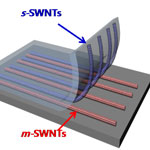 Current production methods for carbon nanotubes (CNTs) result in units with different diameter, length, chirality and electronic properties, all packed together in bundles, and often blended with some amount of amorphous carbon. Often, these mixtures are of little practical use since many advanced applications, especially for nanoelectronics, are sensitively dependent on the structures. Separation of nanotubes according to desired properties is still proving to be a challenging task, especially single-walled carbon nanotube (SWCNT) sorting. The composition of SWCNTs of different types is very similar, but the chemical properties are not. Conventional separation techniques are efficient in separation of carbon nanotubes, but there are many drawbacks. Researchers in Asia have now developed a simple way to realize the separation of single-walled carbon nanotubes via the interaction difference between chemicals and carbon nanotubes.
Current production methods for carbon nanotubes (CNTs) result in units with different diameter, length, chirality and electronic properties, all packed together in bundles, and often blended with some amount of amorphous carbon. Often, these mixtures are of little practical use since many advanced applications, especially for nanoelectronics, are sensitively dependent on the structures. Separation of nanotubes according to desired properties is still proving to be a challenging task, especially single-walled carbon nanotube (SWCNT) sorting. The composition of SWCNTs of different types is very similar, but the chemical properties are not. Conventional separation techniques are efficient in separation of carbon nanotubes, but there are many drawbacks. Researchers in Asia have now developed a simple way to realize the separation of single-walled carbon nanotubes via the interaction difference between chemicals and carbon nanotubes.
Jun 14th, 2011
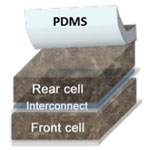 Apart from making graphene, graphene oxide itself itself is a fascinating material that has many intriguing properties. Researchers have now developed a graphene-based conductive glue that can function as a metal-free solder for creating mechanical and electrical connections in organic optoelectronic devices. As a proof-of-concept, they fabricated polymer tandem solar cells - multi-junction photovoltaic devices, in which two sub-cells are stacked to achieve higher overall solar absorption - by a direct 'gluing' process. The water-based sticky interconnect and the associated adhesive lamination process could transform the serial layer-by-layer fabrication of tandem devices into a parallel mode, in which the subcells can be independently fabricated and adjusted to balance their photocurrents for achieving high efficiency.
Apart from making graphene, graphene oxide itself itself is a fascinating material that has many intriguing properties. Researchers have now developed a graphene-based conductive glue that can function as a metal-free solder for creating mechanical and electrical connections in organic optoelectronic devices. As a proof-of-concept, they fabricated polymer tandem solar cells - multi-junction photovoltaic devices, in which two sub-cells are stacked to achieve higher overall solar absorption - by a direct 'gluing' process. The water-based sticky interconnect and the associated adhesive lamination process could transform the serial layer-by-layer fabrication of tandem devices into a parallel mode, in which the subcells can be independently fabricated and adjusted to balance their photocurrents for achieving high efficiency.
Jun 10th, 2011
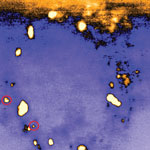 Groundbreaking research has shown a quantum atom has been tracked inside a living human cell and may lead to improvements in the testing and development of new drugs. Researchers conducted studies that confirm that non-invasive quantum measurement is possible on nanodiamonds containing a single nitrogen-vacancy (NV) spin moving within living cells. Studying the quantum properties of a single NV defect within a diamond nanocrystal, the researchers demonstrate a new technique which enables the orientation of a nanoparticle to be determined to an accuracy of less than one degree in an acquisition time of 89 milliseconds. This new technique offers biologists an extra degree of freedom when studying the translational motion of nanoparticles. Monitoring the coherence from a single electron spin paves the ways for nanoscale bio-magnetometry allowing scientists to probe changes in the cell's electromagnetic environment.
Groundbreaking research has shown a quantum atom has been tracked inside a living human cell and may lead to improvements in the testing and development of new drugs. Researchers conducted studies that confirm that non-invasive quantum measurement is possible on nanodiamonds containing a single nitrogen-vacancy (NV) spin moving within living cells. Studying the quantum properties of a single NV defect within a diamond nanocrystal, the researchers demonstrate a new technique which enables the orientation of a nanoparticle to be determined to an accuracy of less than one degree in an acquisition time of 89 milliseconds. This new technique offers biologists an extra degree of freedom when studying the translational motion of nanoparticles. Monitoring the coherence from a single electron spin paves the ways for nanoscale bio-magnetometry allowing scientists to probe changes in the cell's electromagnetic environment.
May 26th, 2011
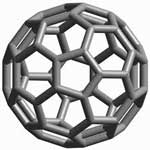 There is a general perception that nanotechnologies will have a significant impact on developing 'green' and 'clean' technologies with considerable environmental benefits. However, the environmental footprint created by today's nanomanufacturing technologies are conflicting with the general perception that nanotechnology environmentally benign. It actually appears that certain nanomaterial production technologies are quite dirty and also have a considerable energy footprint. Determining the full environmental impact of nanomaterials requires a full life cycle assessment. A recent paper takes a look at the material and energy intensity of fullerene production. It finds that the embodied energy of all fullerenes are an order of magnitude higher than most common chemicals.
There is a general perception that nanotechnologies will have a significant impact on developing 'green' and 'clean' technologies with considerable environmental benefits. However, the environmental footprint created by today's nanomanufacturing technologies are conflicting with the general perception that nanotechnology environmentally benign. It actually appears that certain nanomaterial production technologies are quite dirty and also have a considerable energy footprint. Determining the full environmental impact of nanomaterials requires a full life cycle assessment. A recent paper takes a look at the material and energy intensity of fullerene production. It finds that the embodied energy of all fullerenes are an order of magnitude higher than most common chemicals.
Apr 20th, 2011
 Many strategies to develop stretchable electronics rely on engineering new constructs from existing materials, e.g. ultrathin, stretchable silicon structures. Another approach is to fabricate ultrathin CMOS circuits on stretchable materials such as polymers. Nanotechnology allows a novel route to materials and structures that can be used to develop human-friendly devices with realistic functions and abilities that would not be feasible by mere extension of conventional technology. New research suggests devices that can act as part of human skin or clothing, and can therefore be used ubiquitously. Such devices could eventually find a wide range of applications in recreation, virtual reality, robotics and health care.
Many strategies to develop stretchable electronics rely on engineering new constructs from existing materials, e.g. ultrathin, stretchable silicon structures. Another approach is to fabricate ultrathin CMOS circuits on stretchable materials such as polymers. Nanotechnology allows a novel route to materials and structures that can be used to develop human-friendly devices with realistic functions and abilities that would not be feasible by mere extension of conventional technology. New research suggests devices that can act as part of human skin or clothing, and can therefore be used ubiquitously. Such devices could eventually find a wide range of applications in recreation, virtual reality, robotics and health care.
Apr 6th, 2011
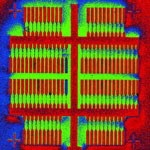 The commercial realization of carbon nanotube-based electronic devices and their integration into the existing silicon-based processor technologies is still hampered by the inability to scale up the - currently lab-based - fabrication processes to manufacture a large number of devices on a single chip. The fundamental issue of carbon nanotube device fabrication still remains the biggest challenge for effective commercialization of nanotube electronics. In a further step towards large-scale integration of single-walled carbon nanotubes (SWCNTs) into complex functional electronic circuits, researchers have now combined a previously developed dielectrophoretic deposition approach with SWCNT sorting using density gradient ultracentrifugation, ensuring high purity of SWCNTs in suspension and consequently in the assembled devices.
The commercial realization of carbon nanotube-based electronic devices and their integration into the existing silicon-based processor technologies is still hampered by the inability to scale up the - currently lab-based - fabrication processes to manufacture a large number of devices on a single chip. The fundamental issue of carbon nanotube device fabrication still remains the biggest challenge for effective commercialization of nanotube electronics. In a further step towards large-scale integration of single-walled carbon nanotubes (SWCNTs) into complex functional electronic circuits, researchers have now combined a previously developed dielectrophoretic deposition approach with SWCNT sorting using density gradient ultracentrifugation, ensuring high purity of SWCNTs in suspension and consequently in the assembled devices.
Mar 22nd, 2011
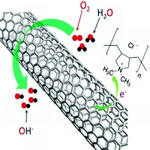 The efficiency of catalyzing the oxygen reduction reaction (ORR) - the process that breaks the bonds of oxygen molecules - to a large degree determines the electrochemical performance of fuel cells. Platinum and platinum-based composites have long been considered as the most efficient ORR catalysts. In their search for practically viable non-precious metal ORR catalysts, researchers have also been investigating vertically-aligned nitrogen-containing carbon nanotubes. Having a strong electron-withdrawing ability, poly(diallyldimethylammonium chloride) (PDDA) was used to create net positive charge for carbon atoms in the nanotube carbon plane via intermolecular charge transfer. The resultant PDDA functionalized/adsorbed carbon nanotubes were demonstrated to act as metal-free catalysts for oxygen reduction reaction in fuel cells with similar performance as platinum catalysts.
The efficiency of catalyzing the oxygen reduction reaction (ORR) - the process that breaks the bonds of oxygen molecules - to a large degree determines the electrochemical performance of fuel cells. Platinum and platinum-based composites have long been considered as the most efficient ORR catalysts. In their search for practically viable non-precious metal ORR catalysts, researchers have also been investigating vertically-aligned nitrogen-containing carbon nanotubes. Having a strong electron-withdrawing ability, poly(diallyldimethylammonium chloride) (PDDA) was used to create net positive charge for carbon atoms in the nanotube carbon plane via intermolecular charge transfer. The resultant PDDA functionalized/adsorbed carbon nanotubes were demonstrated to act as metal-free catalysts for oxygen reduction reaction in fuel cells with similar performance as platinum catalysts.
Mar 21st, 2011
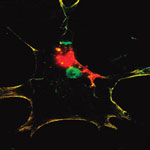 Owing to their large surface area, strong infrared photoluminescence and magnetic properties, nanodiamonds are promising for various biomedical applications, including as drug/gene carriers and alternatives to the current bio-imaging platforms. However, the biomedical applications will hardly be realized unless the potential hazards of nanodiamonds to humans and other biological systems are ascertained. The biocompatibility of nanodiamonds at the cellular level has been confirmed by many independent studies. Following these earlier cytotoxicity studies, many groups have used nanodiamonds and their functionalized derivatives for drug/gene deliveries. In spite of the earlier reports that nanodiamonds are biocompatible at the cellular level, researchers have now demonstrated in a new study that nanodiamonds can activate DNA repair proteins in embryonic stem cells, suggesting possible DNA damages.
Owing to their large surface area, strong infrared photoluminescence and magnetic properties, nanodiamonds are promising for various biomedical applications, including as drug/gene carriers and alternatives to the current bio-imaging platforms. However, the biomedical applications will hardly be realized unless the potential hazards of nanodiamonds to humans and other biological systems are ascertained. The biocompatibility of nanodiamonds at the cellular level has been confirmed by many independent studies. Following these earlier cytotoxicity studies, many groups have used nanodiamonds and their functionalized derivatives for drug/gene deliveries. In spite of the earlier reports that nanodiamonds are biocompatible at the cellular level, researchers have now demonstrated in a new study that nanodiamonds can activate DNA repair proteins in embryonic stem cells, suggesting possible DNA damages.
Mar 10th, 2011
 Current production methods for carbon nanotubes (CNTs) result in units with different diameter, length, chirality and electronic properties, all packed together in bundles, and often blended with some amount of amorphous carbon. Often, these mixtures are of little practical use since many advanced applications, especially for nanoelectronics, are sensitively dependent on the structures. Separation of nanotubes according to desired properties is still proving to be a challenging task, especially single-walled carbon nanotube (SWCNT) sorting. The composition of SWCNTs of different types is very similar, but the chemical properties are not. Conventional separation techniques are efficient in separation of carbon nanotubes, but there are many drawbacks. Researchers in Asia have now developed a simple way to realize the separation of single-walled carbon nanotubes via the interaction difference between chemicals and carbon nanotubes.
Current production methods for carbon nanotubes (CNTs) result in units with different diameter, length, chirality and electronic properties, all packed together in bundles, and often blended with some amount of amorphous carbon. Often, these mixtures are of little practical use since many advanced applications, especially for nanoelectronics, are sensitively dependent on the structures. Separation of nanotubes according to desired properties is still proving to be a challenging task, especially single-walled carbon nanotube (SWCNT) sorting. The composition of SWCNTs of different types is very similar, but the chemical properties are not. Conventional separation techniques are efficient in separation of carbon nanotubes, but there are many drawbacks. Researchers in Asia have now developed a simple way to realize the separation of single-walled carbon nanotubes via the interaction difference between chemicals and carbon nanotubes.
 Subscribe to our Nanotechnology Spotlight feed
Subscribe to our Nanotechnology Spotlight feed





